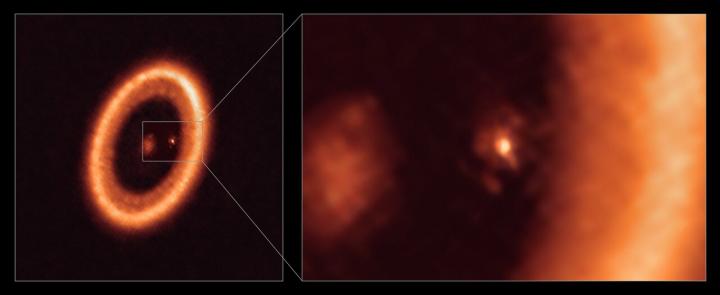
New observations published in The Astrophysical Journal Letters show that there is a potential exomoon forming around an exoplanet. And we have images!
Using the Atacama Large Millimeter/submillimeter Array (ALMA), scientists detected a circumplanetary disk around exoplanet PDS 70c, which is a Jupiter-like planet orbiting a star about 400 light-years away. This disk surrounds the planet, similar to how protoplanetary disks surround a star, and it’s full of dust that could be turned into a moon. An exomoon. And we have managed to get a picture of that disk. What a time to be alive, people.
Here’s what we basically know of planetary formation. The details get murky, so this is simply an upper-level understanding. A star forms and is surrounded by a circumstellar disk full of dust. That dust can then coalesce into planets, which will pull more and more dust and debris into them and grow as they collect material. Not all of the dust ends up in the planet but can turn into a circumplanetary disk of dust that now orbits the planet and could similarly coalesce into a moon or three. Lead author Myriam Benisty commented: Our ALMA observations were obtained at such exquisite resolution that we could clearly identify that the disk is associated with the planet and we are able to constrain its size for the first time.
The diameter of this moon-forming disk is comparable to that of the Sun-to-Earth distance and contains enough mass to form no more than three satellites the size of our own Moon.
Now, there is another Jupiter-like planet called PDS 70b in the system. That could mean that 70c starved its neighbor of dust while they were being born. Not very nice, but we could be wrong, with further observations from the upcoming Extremely Large Telescope giving us even more information about this system.
More Information
Center for Astrophysics press release
ESO press release
“A Circumplanetary Disk around PDS70c,” Myriam Benisty et al., 2021 July 22, The Astrophysical Journal Letters




 Join the Crew!
Join the Crew!
 Escape Velocity Space News
Escape Velocity Space News
0 Comments